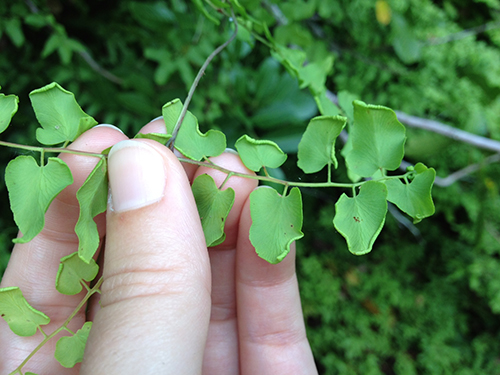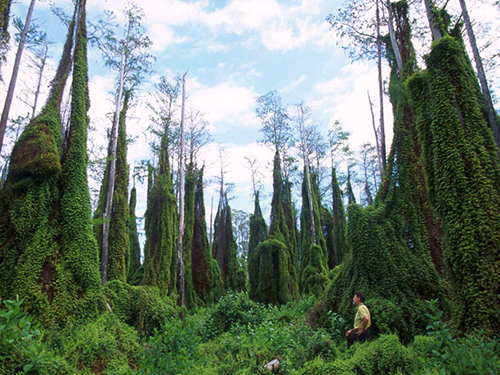Old World Climbing Fern
Origin:
Africa, Asia, and Australia
Introduction to Florida:
Escaped cultivation (first reported in the wild in 1965 in Martin County)
Stage on Invasion Curve:
Long-term management



Description
Old World climbing fern can grow horizontally or vertically, often reaching 60 feet or more into tree canopies. The long vines, or “rachises,” grow from underground rhizome networks and form dense “skirts” around tree trunks. Old World climbing fern produces two types of fronds: sterile and fertile. The fertile fronds have fingerlike projections that bear thousands of spores which are dispersed by the wind.
Impacts
Old World climbing fern invades developed areas and ecologically sensitive natural areas. It grows up and over native trees and shrubs, reducing plant diversity and degrading habitats. It is capable of covering large areas, including entire tree islands. It also acts as a fire ladder and causes great destruction when it carries fire into the canopy and other areas not adapted to fires.
Where to Find Them
In south and central Florida, Old World climbing fern is widespread in wetlands and other moist habitats including Everglades tree islands, bald cypress domes, sawgrass prairies, and pine flatwoods. It also occurs in isolated populations in north Florida.
Distribution Maps
What You Can Do
Remove Old World climbing fern from your property and plant native species in its place. Multiple herbicide treatments are often required to kill Old World climbing fern. The aboveground portion of the plant will die quickly, but herbicides move poorly within the root system so the plants can regrow from the intact roots.
Report Old World climbing fern in natural areas on IveGot1.org or using the IveGot1 reporting app.
Biological Control
The United States Department of Agriculture Animal and Plant Health Inspection Service (USDA/APHIS) recently approved the release of three species of arthopods that feed specifically on Old World climbing fern. Two of these species, the brown lygodium moth larvae (Neomusotima conspurcatalis) and a microscopic mite (Floracarus perrepae) are being reared and released as part of the Comprehensive Everglades Restoration Plan (CERP).
More Information
Publications
- Natural Area Weeds: Old World Climbing Fern (Lygodium microphyllum) (UF)
- Old World Climbing Fern – Find it, Report it, Kill it (FLEPPC)
- Identification and Biology of Nonnative Plants in Florida’s Natural Areas (UF)
- Help Protect Florida’s Natural Areas from Non-Native Invasive Plants (UF)
- Explore your AlterNatives (FLEPPC)
- Old World Climbing Fern Management Plan (FLEPPC)






